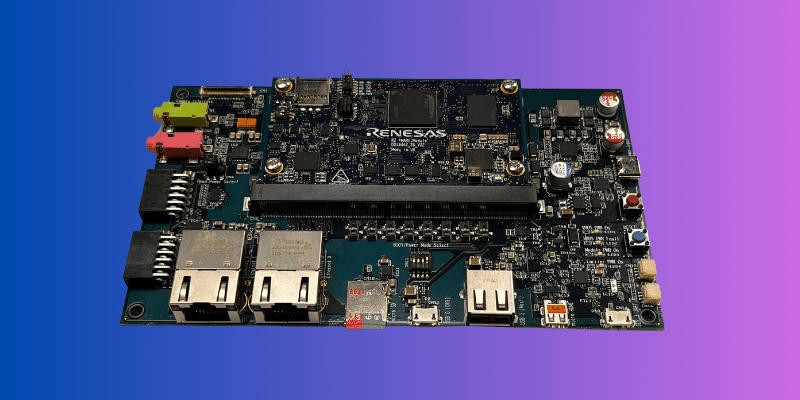Overview
The RZ/V2L MPU includes a Cortex-A55 (1.2 GHz) CPU and an integrated AI accelerator, DRP-AI, designed to improve machine vision processing. DRP-AI is composed of DRP and AI-MAC. The device also provides a 16-bit DDR3L/DDR4 memory interface, an integrated Arm Mali-G31 3D graphics engine, and an H.264 video codec.
DRP-AI Features
DRP-AI delivers power efficiency that can allow operation without additional cooling such as heatsinks or fans. AI inference can be implemented in consumer and industrial devices, including point-of-sale terminals. DRP-AI supports real-time AI inference and image processing, including camera functions such as color correction and denoising, which can remove the need for an external image signal processor.
Platform Compatibility
RZ/V2L is package- and pin-compatible with RZ/G2L, enabling RZ/G2L users to upgrade to RZ/V2L for additional AI capabilities without modifying system configurations, helping to keep migration costs low.
Pretrained Plant Leaf Disease Classification Model
A pretrained plant leaf disease classification model is provided for RZ/V2L. The model classifies 38 different leaf disease or healthy conditions across 14 plant species.
Supported Plants and Leaf Conditions
| Plant | Leaf Condition |
|---|---|
| Apple | Apple scab, Black rot, Cedar apple rust, Healthy |
| Blueberry | Healthy |
| Cherry | Powdery mildew, Healthy |
| Corn | Gray leaf spot, Common rust, Northern leaf blight, Healthy |
| Grape | Black rot, Esca (black measles), Leaf blight (Didymella bryoniae leaf spot), Healthy |
| Citrus | Huanglongbing (citrus greening) |
| Peach | Bacterial spot, Healthy |
| Bell pepper | Bacterial spot, Healthy |
| Potato | Early blight, Late blight, Healthy |
| Raspberry | Healthy |
| Soybean | Healthy |
| Pumpkin | Downy mildew |
| Strawberry | Leaf scorch, Healthy |
| Tomato | Bacterial spot, Early blight, Late blight, Septoria leaf spot, Fusarium wilt leaf spot, Spider mite, Two-spotted spider mite, Target spot, Tomato yellow leaf curl virus, Tomato mosaic virus, Healthy |
Runtime Modes
The application supports three runtime input modes:
- MIPI CSI camera input
- Image file input
- Video file input
Example Output
The classification result, inference time (ms), and score (%) are displayed in the upper-left corner. Frames per second (FPS) is shown in the upper-right corner.
Hardware and Software Requirements
| Hardware | Software |
|---|---|
| RZ/V2L evaluation board and a Coral camera; USB mouse; USB keyboard; USB hub; HDMI display and Micro HDMI cable | Ubuntu 20.04; OpenCV 4.x; C++11 or later |
Building the Sample Application
Building is optional if you use the provided prebuilt binaries. Before compiling, ensure the RZ/V2L AI SDK is prepared.
- Clone the source code to the local machine
- Start Docker
- Mount the data directory to the rzv2l_ai_sdk_container
- Enter the sample source directory
- Compile the source
mkdir -p build && cd build
cmake -DCMAKE_TOOLCHAIN_FILE=./toolchain/runtime.cmake ..
make -j$(nproc)
The application plant_leaf_disease_classify should appear in src/build.
Application Deployment
Copy the following files to /home/root/tvm on the SD card:
- All files from the sample executable directory
- If the application was modified, copy plant_leaf_disease_classify from src/build
Running the Sample Application
When the input is a MIPI Coral camera:
cd /home/root/tvm
./plant_leaf_disease_classify CAMERA
When using a static image as input:
cd /home/root/tvm
./plant_leaf_disease_classify IMAGE sampleimg.jpg
When using a video file as input:
cd /home/root/tvm
./plant_leaf_disease_classify VIDEO plantvid.mp4
Stopping the Application
Press the Esc key to exit the application.
Dataset
The model was trained using the new-plant-diseases-dataset on Kaggle. The dataset contains approximately 87,000 RGB images of healthy and diseased crop leaves across 38 classes. The dataset was split 80/20 into training and validation sets, and a 33-image test set was created.
Inference Performance
Total AI inference time (preprocessing + model inference): 110 ms
| Training Accuracy | Validation Accuracy | Test Accuracy |
|---|---|---|
| 94.2% | 93.1% | 90.5% |
 ALLPCB
ALLPCB








